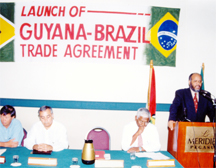Guyana-Brazil relations have been impeded by deficiencies in physical infrastructure and slowed by a feeble foreign service, impotent government bureaucracy, underdeveloped commercial sector and a distrustful political directorate.
Every Guyanese president has had to perform the pilgrimage to Brasilia – the capital of the ‘Colossus of the South’ – at least once. An equally symbolic ritual has been the massive and almost obsessive signing of agreements that accompany every visit without variation. The Cooperative Republic of Guyana and the Federative Republic of Brazil have signed scores of agreements over the last four decades since the two states established diplomatic relations. But, despite assurances of cordiality and commitment, fulfillment of obligations has foundered and accomplishments have been few.
The most spectacular success has been the mid-September commissioning of the Takutu River Bridge – the first physical link between Guyana and Brazil – which Brazil’s President Luis Inacio Lula da Silva described as “a concrete and irreversible step.” That was truly a remarkable diplomatic, economic and geographical landmark but the progress has been slow and it has taken 27 years and five presidents on the Guyana side to reach thus far.
Paper Tigers

President Forbes Burnham, back in October 1982, visited his counterpart President João Figueiredo and the initial agreement for the construction of the highway − which was intended eventually to link Boa Vista and Georgetown − was signed. This visit was accompanied by a raft of agreements for cooperation in agriculture, energy development, education, health, scientific research and other things.
President Desmond Hoyte, seven years later in October 1989, visited Brazil and, with his counterpart President José Sarney, signed the agreement for the highway construction to start with Brazilian financing. The next month, Guyana’s Ministry of Communications and Works entered an agreement with the Brazilian construction firm Paranapanema, to construct the highway. And so the story has been going slowly until last month’s event.
Even the ceremonial commissioning of the Takutu River Bridge had to be plastered with more paper. Minister of Foreign Affairs Carolyn Rodrigues-Birkett and her Brazilian counterpart Celso Amorim signed several technical cooperation agreements for the promotion of trade and investment and a memorandum of understanding to create a frontier committee. Rodrigues-Birkett also signed a cooperation agreement with the Brazilian Minister of Defence Nelson Jobim on national defence matters.

Back in April 2002, Secretary General of the Ministry of External Relations of Brazil Ambassador Osmar Vladimir Chohfi led a 15-member delegation to Georgetown and signed several bilateral agreements. Minister of Home Affairs Ronald Gajraj signed a memorandum of understanding between the Guyana Police Force and Brazil’s Federal Police under which the two governments were required to put administrative measures in place to establish a joint committee of the two forces to make recommendations for more effective law enforcement between the two countries.
Minister of Fisheries, Other Crops and Livestock Satyadeow Sawh signed an agreement for two agriculture-related projects. The Brazilian Government was required to send specialists to advise on the identification and introduction of an appropriate variety of cassava for food security in the hinterland and the Acoushi Ant control project was intended to incorporate agro-ecological systematic practices in the control of Acoushi ants in the hinterland.
On the same occasion, Chief-of-Staff of the Guyana Defence Force Brigadier Michael Atherly also signed an agreement to stabilise the site in the Loo Lands where the arsenal explosion had occurred. That agreement also provided for the Brazilian Government to send specialists to train Guyanese military technicians to deal with explosives and explosive devices.
President Lula da Silva’s state visit in February 2005 provided another wave of agreements. Guyana’s Minister of Foreign Affairs Rudy Insanally and Brazil’s Minister of External Relations Celso Amorim signed one agreement to facilitate cooperation between Guyana’s non-existent Foreign Service Institute and Brazil’s prestigious Rio Branco Institute, in areas of information technology exchange and capacity building.
Minister of Education Dr Henry Jeffery and Brazil’s Darso Germo signed a second agreement on education − to allow collaboration in post-graduate training, distance education and use of information technology, adult education, planning and educational management and vocational and professional education − between the two countries. The Ministers of Health, Dr Leslie Ramsammy and Humberto Costa, signed yet another agreement − complementing the basic January 1982 agreement on technical cooperation – for cooperation in health, especially in border districts and to establish a bi-national commission on health for that purpose.
Reams of agreements languish undisturbed in the filing cabinets of the Ministry of Foreign Affairs.
President Jagdeo has paid several visits to Brazil over the past decade. In July 2003, accompanied by Minister of Foreign Affairs Rudy Insanally, Minister of Transport and Hydraulics Anthony Xavier, Minister of Education Henry Jeffrey, Minister of Tour-ism Manzoor Nadir and Chief Executive Officer of the Guyana Office for Investment Geoffrey da Silvia, the President visited Brazil. Important agreements were reached in the Trade Sector including the Partial Scope Agreement and the Land Cargo Transportation Agreement.
From that visit, Guyana expected to benefit from assistance in agriculture and education and cooperation in the Environmen-tal, National Resources, Energy and Security sectors, mainly the deep harbour project and the Guyana-Brazil highway project. Less than three months later, Jagdeo paid a weekend visit to the State of Roraima to take a look at various agro-industrial enterprises.
Everything seemed to be coming up roses.
Assymetrical relations
President Jagdeo has affirmed, and his Ministers of Foreign Affairs ritually iterate as an article of faith, that Guyana’s long-term prosperity is linked to the development of Brazil and other countries of the South. Speaking about the recent official opening of the Takutu River Bridge, Jagdeo said that he had “excellent meetings” with Brazilian President Luiz Inacio Lula Da Silva and other officials. “We have some strong commitments, from the Federal Government in Brazil, to assist us with some of the key projects that we see as vital for our future, as transformative to Guyana…We are not talking about way into the future. We are talking about immediate urgent action to move things forward,” the President stated.
The problem, however, is not one of hosting “excellent meetings” or sharing “strong commitments.” It is one of institutional capacity and organisational capability. Brazil and Guyana make an odd couple − one large, the other small; one rich, the other poor; one with a strong Foreign Ministry and an efficient bureaucracy and the other with a damaged Foreign Service and demoralised Public Service. Guyana, simply, has lost the ability to manage continuous, complex bi-lateral relations with a world-class economy. Takuba Lodge is quite unlikely to evince “immediate urgent action” on anything.
Guyana’s administration is still to understand the need for rebuilding a corps of highly-talented, professional diplomats backed up by a cadre of well-educated Foreign Service officers and public servants in the aftermath of the slash-and-burn excesses of the 1990s. The current administration, however, is still moving in the wrong direction. It has continued to obstruct, or to purge, professional officers and tried to restrict its senior appointments to politicos.
This has had the effect of frustrating experienced officers and of deterring enthusiastic young entrants. It has led to the ossification of the Ministry of Foreign Affairs, the degeneration of the missions and the destruction of the Foreign Service Institute. Inexorably, it contributed to the stultification of relations with Brazil.
Ambassador Arthur Vivacqua Correa Meyer of Brazil, in an interview with this newspaper in May this year made it clear – politely but pointedly – where the deficiencies lay:
“In terms of trade, Brazil has an agreement – the so-called Partial Scope Agreement with a number of territories within the framework of the Latin American Integration Association by which Brazil grants tariff preferences to Guyana. The Brazilian government is open to the idea of extending the list of those tariff preferences that are granted at present to Guyana. Right now we do not have a very high volume of bilateral trade. The latest figures that I have indicate that Brazilian exports to Guyana reach a figure a little over US$20M a year. We think that the deficiencies in physical infrastructures are mainly responsible for this.”
The continental system
Addressing a workshop hosted by the Initiative for Integration of Regional Infrastructure in South America held under the theme Future of South America: building a strategic vision of South American physical integration held in Georgetown in November 2005, Prime Minister Samuel Hinds acknowledged that there were significant benefits to be obtained if the South American countries expanded infrastructural linkages throughout the region. But Guyana is being left behind in the thrust towards regional integration and, because of its ‘deficiencies,’ has had little contributions to make about the strategic purpose of the initiative.
If the Government of Guyana is serious about becoming an active player in the South American continental system and taking advantage of its still favourable relations with Brazil, it needs to make serious changes in its style of government, starting with the convalescence of the anaemic Ministry of Foreign Affairs. Flowery declarations are not enough. While Guyana has been dawdling on fulfilling its obligations and exploiting the opportunities offered under the bi-lateral agreements, Brazil has been aggressively and ambitiously pursuing what it perceives to be its continental, or even global, destiny.
One indication of Guyana’s baffling blasé attitude to continental matters on which Brazil lays great store was the recent response to the security crisis in Unión de Naciones Suramericanas – Union of South-American Nations – UNASUR. What meaning could be attached to the administration’s decision to send the Minister of Labour, Human Services and Social Security Manzoor Nadir to represent Guyana at that critical meeting of UNASUR’s Defence and Foreign Policy Ministers in Quito in mid-September?
Last year, Brazil had sent high-level national security delegations here. Its Minister of Defence Nelson Azevedo Jobim and his team met President Bharrat Jagdeo to discuss the formation of the Conselho Sul-Americano de Defesa (South American Defence Council) – UNASUR’s military coordinating component, in April. A delegation of the Comissão de Relações Exteriores e Defesa Nacional (Committee on Foreign Affairs and National Defence) of the Chamber of Deputies of Brazil’s National Congress led by Senator Heráclito Fortes followed. In the latter case, however, the Government Information Agency published photographs of the President, unaccompanied by any advisers, officials, ministers or even note-takers, meeting the visitors. Again, what meaning could be attached to the President’s empty-handed appearance at that meeting?
Guyana has weighty continental obligations but could derive much more benefit than it does now. Holding the chairmanship of the Rio Group, Guyana hosted the 19th summit here in March 2007 and it is due to assume UNASUR’s rotating chairmanship in 2010. This country needs to strengthen its governmental organisation and quicken the pace of its administration if it is to make itself ready for this continental commitment and if it is to be in a position to exploit the opportunities to promote its development.





